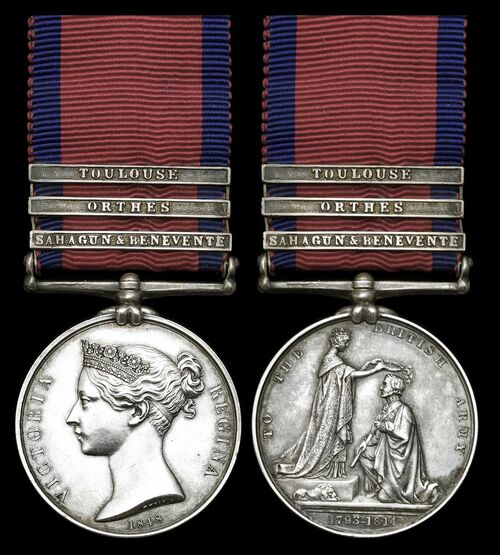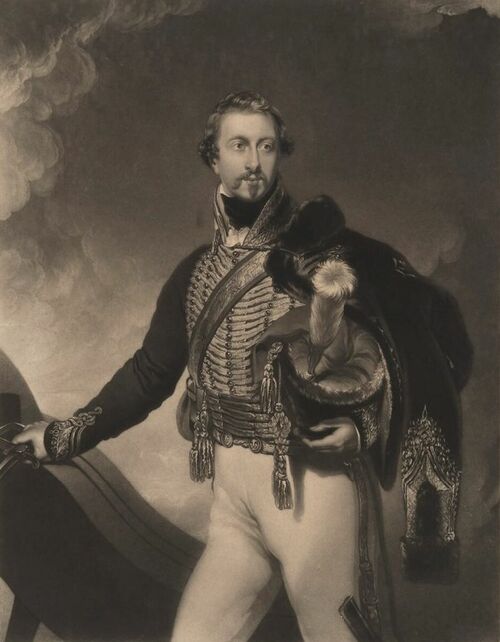Auction: 23003 - Orders, Decorations and Medals
Lot: 7
The fascinating Military General Service Medal worn by Captain The Honourable H. C. Lowther, 7th (The Queen's Own) Regiment of (Light) Dragoons (Hussars), son of the 1st Earl of Lonsdale, who served with distinction during the Peninsular War and later became Father of the House of Commons with a remarkably long political career of some fifty-five years
Military General Service 1793-1814, 3 clasps, Sahagun & Benevente, Orthes, Toulouse (Hon. H.C. Lowther. Capt. 7th Hussars.), naming engraved in the classic 'Hunt & Roskell' style, about extremely fine
Provenance:
Christie's, 22 October 1980, the Lot bearing the following description: 'in box of issue, extremely fine, together with two identical medals, one renamed to same recipient, the other with name erased and false clasps, nearly extremely fine and nearly very fine (3)'; this Lot was shortly after followed by two further Lots of Orders, Decorations and Medals awarded to Hugh Cecil Lowther and his wife, the 5th Earl and Countess of Lonsdale respectively. Of the three medals relating to The Hon. H.C. Lowther, the erased example was subsequently retailed by Spink & Son in the Numismatic Circular, January 1981; the example with its' original box of issue was subsequently retailed by Spink & Son in the Numismatic Circular, February 1981.
Henry Cecil Lowther was born on 27 July 1790 into one of the premier aristocratic families of the time: second son of William Lowther, 1st Earl of Lonsdale and his wife Lady Augusta - herself eldest daughter of the 9th Earl of Westmorland and a granddaughter of the 1st Duke of Ancaster and Kesteven. Initially raised at the ancestral home of Lowther Castle, young Lowther then removed to Westminster School; at the age of 17 he was commissioned Cornet in the smart and socially prestigious 7th (The Queen's Own) Regiment of (Light) Dragoons (Hussars), which had received their rather ponderous official title the same year. Promoted Lieutenant in July 1808, in October of that year the 7th were posted abroad for service with General Sir John Moore's army in the Iberian Peninsula, where they distinguished themselves covering the withdrawal of Moore's army in the face of overwhelming numbers of French troops commanded by none other than Napoleon himself.
"Blood and Slaughter - March!": action at Sahagun and Benavente
The 7th, along with the 10th and 15th Hussars, formed a brigade under the command of Brigadier Sir John 'Black Jack' Slade, an officer who became infamous for his stirring pre-battle speeches rather than his competence in situations of actual combat. With the objective of covering the withdrawal of the army, the light cavalrymen of the Hussar Brigade were constantly at the rear of the retreat and in the position of most danger; the harsh conditions of a cold Spanish winter is also recorded as being particularly unpleasant to both men and horses. At Sahagun (21 December 1808), the 15th Hussars and a battery of the Royal Horse Artillery successfully charged and routed a numerically superior force of French cavalry; the 10th Hussars joined in the pursuit and their foe were completely routed with significant casualties. At Benavente (29 December), however, the action was a far more hotly-contested affair. Covering the destruction of several bridges over the river Esla to slow the French pursuit, a brigade of French Imperial Guard cavalry (comprising some 600 men and commanded by one of Napoleon's most favoured generals, Charles Lefebvre-Desnouettes) decided to advance on the town of Benavente itself; upon crossing the river they ran into the outlying British piquet, comprising several men of the 7th Hussars under the command of none other than Lieutenant Lowther who, in the words of the Regimental History, were 'sharply engaged'. Lowther and his men - first to come into contact with the French that day - withdrew to the main piquet, commanded by Colonel Loftus Otway of the 18th Hussars: together with the piquets of the other regiments in the Brigade, and buying time for the main body to form up in the saddle, Otway ordered a charge against an isolated squadron of Chasseurs a Cheval and succeeded in routing them utterly. The situation was reversed, however, when a French counter-attack hit the disordered piquets and now a stalemate of swift backwards-and-forwards charges and counter-charges developed across the plain before the town. Lowther would, undoubtedly, have been in the thick of the fighting throughout and the Regimental History further notes that: 'The piquet of the Seventh Hussars suffered severely, nearly every man being either killed or wounded' (Historical Record of the Seventh, or Queen's Own Regiment of Hussars: Containing an Account of the Origin of the Regiment in 1690 and of its' Subsequent Services to 1842, London 1842, refers).
Finally - and with impeccable timing - the remainder of the Hussar Brigade arrived on the field and, in a great last charge, the British cavalrymen (along with their comrades of the 3rd Hussars, King's German Legion), swept the disorganised French back towards the river. Many enemy horsemen were captured, including Lefebvre-Desnouettes himself, and the British regained the contested ground.
After the battle the Brigade continued its' withdrawal along with the rest of the British Army; present during - but not participating in - the Battle of Corunna, the 7th were back in England by early 1809 - but not before one of the ships transporting 116 men and 44 horses was wrecked in a storm with only seven survivors: a cruel twist of fate after enduring and overcoming the battles, trials and tribulations of the preceding year. It was not until August 1813 that the 7th Hussars returned to the Iberian Peninsula, with Lowther now a Captain (promoted 4 October 1810); in civilian life he was also Member of Parliament for Westmorland, the start of a political career which was to last the rest of his life. The 7th greatly distinguished themselves at the Battle of Orthez (27 February 1814) when, towards the end of the Allied victory, they rode down two fleeing battalions of French infantry and came to the notice of Wellington himself, who gave them a well-deserved 'Mention' in his Despatch: "Lieutenant-General Sir Stapleton Cotton took advantage of the only opportunity which occurred, to charge with Major-General Lord Edward Somerset's brigade in the neighbourhood of Sault de Navailles, where the enemy had been driven from the high road by Lieutenant-General Sir Rowland Hill. The Seventh Hussars distinguished themselves upon this occasion, and made many prisoners" (ibid). At the Battle of Toulouse (10 April 1814) the 7th provided support for the infantry attacks, and later patrolled the army's lines of communication before being sent home at Britain on 1 June.
The 7th Hussars participated in the Waterloo Campaign, and though Lowther (by this time a brevet Major) was still with the regiment, for an unrecorded reason he was not with them for that final climactic action of the Napoleonic Wars. In November 1815 he transferred to the 10th (Prince of Wales's Own) Regiment of (Light) Dragoons (Hussars) - another regiment with an exceptional service record during the Napoleonic Wars and, of course, which Lowther would have fought with side-by-side at Benavente. His time in the 10th was not to last long, however, as on 12 April 1817 he transferred to the infantry and became Lieutenant-Colonel (commanding) the 12th (East Suffolk) Regiment of Foot; it was with this unit and rank that he went on Half-Pay a year later.
Though his years of active service may have been behind him, soldiering was not and in 1819 (the year of the 'Peterloo Massacre') he personally raised six independent troops of the Westmorland Yeomanry Cavalry; initially appointed Major-Commandant of the corps, he was promoted Lieutenant-Colonel Commandant in 1821 before being made Colonel of the Royal Cumberland Militia in 1830. A stalwart of the local squirearchy, in addition to his part-time military position he was a Deputy-Lieutenant for both Cumberland and Rutland, and a Justice of the Peace for Westmorland, Cumberland, and Leicester. His political life continued, too, and he was consistently returned as M.P. for Westmorland up until his death - though he was apparently known as the 'silent Colonel' and made very few speeches ('The History of Parliament: the House of Commons 1820-1832', ed. D.R. Fisher, 2009, 'LOWTHER, Hon. Henry Cecil (1790-1867), of Barleythorpe, Rutland', refers). Fascinatingly, an Army officer-acquaintance made a short pen-portrait of him around this time which, though Lowther undoubtedly led a life of wealth and privilege, perhaps suggests he bore the scars of hard campaigning for the rest of his life: 'Such a figure you can hardly conceive. His face had come in contact with the mountain wind and sun, and no skin was left. Indeed, the old comparisons of a chapped face being like the bark of a plum tree was not the least exaggerated.' (ibid). In 1862 he was made Father of the House, as the longest-sitting Member of Parliament, and notably was also the last M.P. to be elected during the reign of King George III.
Life was not all work and no play, however, and Lowther was also noted as an enthusiast of cricket: he played 47 first-class matches between 1818 - 1839, mostly for the Marylebone Cricket Club (the famous 'M.C.C.') but also in the 'Gentlemen v Players' series and for Hampshire and Surrey. On 19 May 1817 he married Lady Lucy Eleanor Sherard, daughter of the 5th Earl of Harborough; they went on to have seven children. Upon Lowther's death (6 December 1867) his eldest son, Henry, succeeded to the Lonsdale title as Lowther's elder brother had no legitimate male heirs. The ancestral home, Lowther Castle, still exists and during his father's time was much patronised by such notable individuals as the poet William Wordsworth and the artists J.M.W. Turner and Sir Thomas Lawrence.
Postscript
Taking into account Lowther's subsequent military service and the composition of the original Lot when sold by Christie's in 1980, it seems fair to surmise that upon receiving his original medal it remained stored away in its' original box of issue; Lowther then obtained another medal - perhaps via Hunt & Roskell - which he requested the company to engrave with his details in exactly the same manner as his officially-issued award; he subsequently wore this in later life and it is this medal which is offered here.
For further reading on the British Army's regiments of Hussars during the Napoleonic Wars, the book 'The Prince's Dolls: Scandals, Skirmishes and Splendours of the Hussars, 1793-1815 (John Mollo, 1997) is to be recommended.
Subject to 20% VAT on Buyer’s Premium. For more information please view Terms and Conditions for Buyers.
Sold for
£1,000
Starting price
£550









